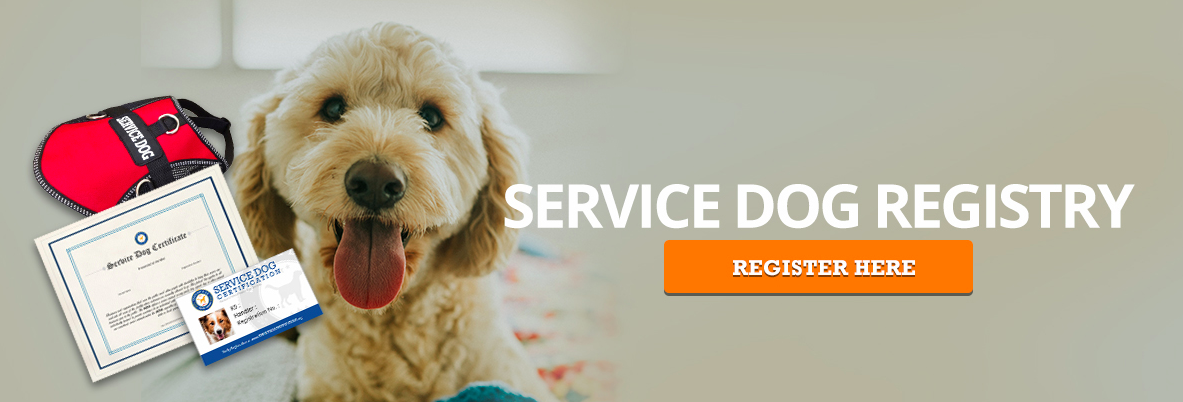Everything to Know about Diabetic Service Dogs

A diabetic service dog can smell when your blood sugar levels are getting dangerously high or low. These dogs are trained to let you know when your blood sugar has spiked too high or dropped too low, so you can take action before the problem turns into a medical emergency.
Unlike service dogs that help with mobility or guide work, or psychiatric service dogs that help with mental health concerns, diabetic alert dogs use their incredible sense of smell to detect chemical changes in your breath, saliva, and sweat that happen when glucose levels shift. They’re trained to give you a specific alert, like pawing, nudging, or bringing you supplies, before you even feel symptoms.
This early warning system is important because the dogs are actually sensing the compounds released by the liver when blood sugar levels are either dropping rapidly or are low. Your dog might know about a dangerous blood sugar swing 15-30 minutes before your continuous glucose monitor catches it.
Read on to learn more about diabetic service dogs, what they can do, and which dogs are perfect for the job.
In this article:
- Who can get a diabetic service dog
- How dogs help diabetics and what they can do
- Best breeds for diabetic service dogs
- How to get a diabetic service dog
- Real stories about diabetic service dogs
Who Can Get a Diabetic Service Dog
Both Type 1 and Type 2 diabetes can qualify you for a service dog. The most important factor isn’t which type you have, but whether you experience:
- Frequent dangerous blood sugar swings
- Hypoglycemia unawareness (you can’t feel when your sugar gets low)
- Severe episodes that happen during sleep
- Blood sugar emergencies that put you at risk
Under the Americans with Disabilities Act, service dogs can only be given to people with a qualifying disability. Your diabetes substantially limits one or more major life activities. Many people with insulin-dependent diabetes meet this standard.
You don’t need a doctor’s note or special paperwork. The law focuses on whether your condition limits your daily life, rather than on having the correct forms. The input and advice of your doctor, however, is recommended.
How Dogs Help Diabetics and What They Can Do
Dogs have an incredible advantage when it comes to detecting blood sugar changes. A dog’s sense of smell is up to 100,000 times more sensitive than a human’s, making them excellent service animals for all types of health needs. Dogs possess far more scent receptors in their noses than humans do, and a much larger portion of their brain processes smell information.
When your blood sugar changes, your body releases different chemical compounds. A University of Cambridge study published in Diabetes Care found that when people with Type 1 diabetes experienced low blood sugar, levels of a compound called isoprene in their exhaled breath nearly doubled. For high blood sugar, research suggests that dogs may detect ketones, although this connection requires further study. These scents are completely undetectable to humans, but dogs can pick them up long before symptoms appear.
What Diabetic Service Dogs Can Do During Different Emergency Situations
- When You’re Having a Seizure
Medical response dogs are trained to respond to the symptoms of severe low blood sugar, such as fatigue, loss of consciousness, and seizure-like behavior, to help notify you and others of hypoglycemic events. Your dog might bark to alert family members, lie across you for protection, or even dial a pre-programmed emergency number using a special device. - When You’re Going Into Shock or Passing Out
Service dogs can position themselves to break your fall, then immediately seek help. Some dogs learn to retrieve emergency supplies, such as glucose tablets or insulin, while others are trained to fetch family members or activate medical alert systems. - When You Need Food or Insulin
Service dogs can also retrieve “low” supplies such as food, drinks, or an emergency kit. Many dogs carry emergency supplies in special harnesses and can bring them to you on command. Some even learn to distinguish between “high” and “low” supplies, bringing juice for hypoglycemia or insulin for hyperglycemia.

Best Breeds for Diabetic Service Dogs
The following are some popular breeds for diabetic service dog owners. Remember, however, a service dog can be any breed as long as the dog has the right temperament and trainability.
Golden Retrievers
Many trainers prefer Golden Retrievers because of their versatility, intelligence, calm personality, and good health. Like Labrador Retrievers, Golden Retrievers are intelligent, trainable, and have keen noses. Their friendly and gentle nature also makes them suitable for people of all ages, including children.
Labrador Retrievers
Labrador Retrievers are known for their intelligence, trainability, and friendly nature. These qualities make them one of the best choices for a diabetic-alert dog. They possess a strong sense of smell, allowing them to detect changes in their handler’s blood sugar levels accurately.
Standard Poodles
Standard Poodles make excellent diabetic alert dogs due to their intelligence and loving nature, and they come in a variety of colors. Standard Poodles are highly intelligent and versatile dogs that excel in various roles, including diabetic alert dogs. Poodles are also hypoallergenic, making them an excellent choice for individuals with allergies.
German Shepherds
German Shepherds bring serious intelligence and excellent scent detection abilities to diabetic alert work. They’re confident, loyal working dogs that learn fast and work with intense focus once properly trained. These dogs can also undergo dual-purpose training for both alert and mobility support, which may be necessary if you require physical assistance as well.
The main consideration with German Shepherds is their natural protective instincts. They require extensive early socialization to function effectively in public, as a diabetic alert dog cannot act protectively toward strangers.
Collies (Rough and Smooth)
Both Rough Collies (like Lassie) and Smooth Collies make excellent detection dogs. They’re intelligent, naturally gentle, and have strong work ethics from their herding background. Smooth Collies often work exceptionally well because their short coats need much less maintenance than their fluffy cousins, but they keep the same sweet temperament and intelligence.
Collies tend to be sensitive dogs that respond best to patient, consistent training. They don’t handle harsh corrections well, but they form deep bonds with their handlers.
Border Collies
Border Collies are brilliant problem-solvers with incredible focus. When they lock onto detecting your blood sugar changes, they can become amazingly accurate. Their intelligence and ability to learn quickly make them excellent candidates for complex alert work.
The trade-off is energy. Most Border Collies need several hours of mental and physical exercise daily. They’re best suited for very active people who understand high-drive working dogs.
Sporting Breed Mixes
Mixed breeds, especially sporting dog combinations, often have the best traits from multiple breeds. A Lab-Golden mix or Poodle cross might give you intelligence, trainability, and a great nose all in one package.
Share this image on your site
How to Get a Diabetic Service Dog
Option 1: Adopt and Train
Many successful diabetic alert dogs come from shelters and rescue organizations. The key is finding a dog with the right temperament: highly food motivated, eager to please, and naturally attentive to their handler. You’ll also need to put in the effort to train the dog, ideally with a professional trainer. Check out our guide on how to train a service dog to get a better idea of what that process looks like.
What to Look For:
- Dogs between 1–3 years old (past puppy phase but still trainable)
- Strong food motivation
- Natural attachment to people
- Calm temperament in public settings
- Good health with no chronic issues
Option 2: Nonprofit Organizations and Charities
Several established nonprofits provide diabetic alert dogs, often at reduced cost or free of charge to qualifying families. Here are a couple of notable ones:
- Dogs4Diabetics, a branch of the National Institute for Canine Service and Training, is the oldest accredited service dog provider for people with diabetes.
- Diabetic Alert Dogs of America train high-quality Diabetic Service Dogs for children and adults living with Type 1 and Type 2 diabetes.
Real Stories About Diabetic Service Dogs
According to someone who works with Dogs4Diabetics and has had type 1 diabetes with hypoglycemia unawareness for over 40 years, having a Diabetic Alert Dog “changed my life for the better by helping me keep my blood glucose in a much tighter range, which means fewer health complications and I feel much better both physically and mentally”
She says that her dog, Troy, “has saved my life so many times by alerting me before my glucose dropped to a life-threatening level, that I can’t keep track anymore. Troy tells me long before my CGM detects a rapid drop or rise in my glucose levels, and he does it without that annoying beeping!”
Beyond Just Alerts
The benefits extend far beyond medical alerts. According to one owner, “The dogs provide emotional support, and that’s huge. There’s a lot of depression associated with diabetes, but it’s hard to be depressed when you are woken up by a wet nose and a happy face! The dog also helps people get up and get moving – you can’t lie in bed all day because the dog needs a walk, has to be fed, and taken care of.”
A British study of 17 people found that owners reported positive effects, including fewer paramedic calls, decreased unconscious episodes, and improved independence after getting their dogs. The emotional benefits often matter as much as the medical ones.
A study published in Diabetes Care found significant improvements in owners’ lives: owners reported decreased worry about hypoglycemia and hyperglycemia (61.1%), improved quality of life (75%), and an enhanced ability to participate in physical activities (75%). The same study found that people experienced fewer severe and moderate hypoglycemic episodes and even saw improvements in their A1C levels after getting their dogs.
This article is for informational purposes only and should not replace professional medical advice. Always consult with your healthcare provider before making decisions about diabetes management tools, including service dogs.
About the Author: The writing team at Service Dog Certifications is made up of folks who really know their stuff when it comes to disability laws and assistance animals. Many of our writers and editors have service dogs themselves and share insights from their own experiences. All of us have a passion for disability rights and animals.
Latest Posts

Dangerous Materials Hiding in Your Dog Products
Jake’s German Shepherd began developing strange rashes around his collar. Three vet visits later, they figured out the leather was treated with chromium — a chemical that irritates sensitive skin. Jake had no idea his dog’s collar contained industrial chemicals. Most dog owners don’t know what goes into the products they buy. Many companies use […]

Read More

Can You Bring a Service Dog to a Basketball Game?
Yes, you absolutely can bring your service dog to basketball games. Whether you’re heading to your local high school tournament, a packed college rivalry game, or splurging on NBA tickets, the Americans with Disabilities Act protects your right to be accompanied by your service dog anywhere the public can go. When you arrive, venue employees […]

Read More

Best Pet Health Insurance Providers
If you own a pet, you know how important — and expensive — vet care can be. One way to offset those costs is to purchase pet health insurance. Like typical health insurance, pet insurance is available at many price points, and can cover all, most, or only some of your vet-related costs. It can […]

Read More

